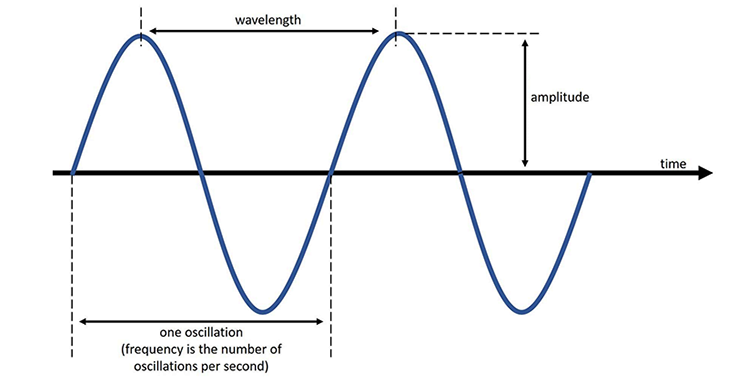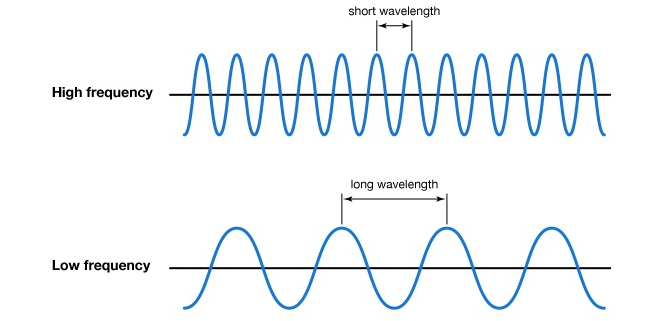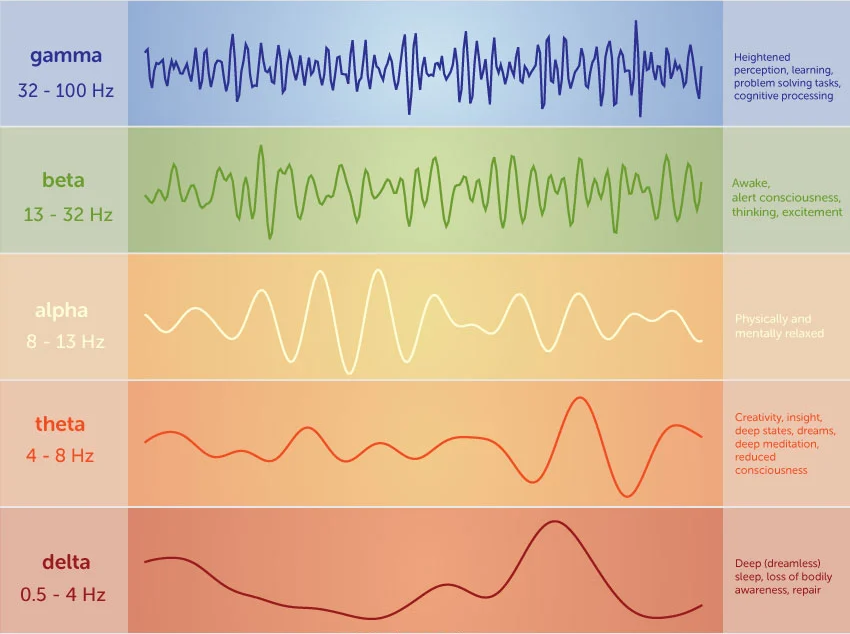For thousands of years people have practiced meditation to reduce stress, find inner peace, release negative emotions, gain confidence and stimulate their brains. With light and sound meditation — achieved with earbuds and special glasses to experience light and sound at different frequencies — you can achieve all that and more. And in a more interesting and unexpected way than with traditional meditation.
Contents
Brain Waves and Meditation
Meditation is first and foremost thought of as a spiritual experience. And it is. But there’s also science and physiology involved. Changes in brain wave — electromagnetic energy — frequency occurs as a result of meditating. This fluctuation affects mood, energy level, focus, heart rate, anxiety level, and more.
What Are Brain Waves?
The human brain has 100 billion neurons, or brain cells, with each connected to hundreds or thousands of other neurons in vast networks that facilitate neuron communication. This communication takes place in the form of minute electrical currents travel in waves from neuron to neuron — a synchronized electrical activity known as brain waves (also written as one word: brainwaves).
Brain waves aren’t theoretical — they’re real electrical signals that can be detected and measured. When millions of neurons interact in a specific way at the same time, the electrical activity is strong enough to be detected outside the brain. That’s accomplished through electroencephalography, better known as EEG. By placing special electrodes at specific places on the scalp, this neuron activity can be amplified and then visualized on a monitor or graphed on paper.
Brain Wave States
One way that brain waves transmit information is in their frequency of oscillation — their rate of repetition. A wave continuously rises and falls, with one oscillation, or cycle, considered to be measured from a point of the wave to the point after it rises and falls and ends up back at the same position, like this:

The frequency of a wave is the number of oscillations the wave covers in a particular period of time. Frequency is measured in a unit called hertz (abbreviated as Hz) — the number of oscillations in one second. A short wavelength has a higher frequency than a long wavelength (because the short wavelength means more oscillations, or cycles, complete in one second):

In terms of frequency, brain waves are categorized into five different states, with each state named after a Greek letter.

As illustrated and summarized in the above figure, the five brain wave states, or categories, from highest frequency to lowest frequency are gamma (γ), beta (β), alpha (α), theta (θ), and delta (δ). Each brain wave state roughly correlates with a person’s state of being. That is your emotions, thoughts, sense of well-being, energy level, and so forth are dependent on the brain wave state you’re currently experiencing. It should be noted that the brain doesn’t function exclusively in just one brainwave state at a time. Instead, there are brain waves of all states always present simultaneously, but one of the states will be dominant at any particular time.
Gamma
Gamma brain waves have the highest frequency — they’re the fastest of the five brain wave states. Traits associated with gamma brain waves are being at a peak mental state, learning, and heightened perception. When a person’s brain waves are predominantly gamma there is usually simultaneous processing of information from different areas of the brain.
Beta
Beta brain waves are a step down in frequency and speed from gamma waves. Beta waves aren’t associated with peak performance like gamma waves, but they are still associated with focused concentration, active thinking, and a heightened state of alertness. If you’re having an active conversation or are engaged in sports, your brain waves are mostly in the beta state.
Alpha
Alpha waves are a step down from beta waves in terms of frequency and speed. Here a person will be in physically and mentally relaxed, reflective, and may be able to access levels of creativity deeper than when in other brain wave states. When performing yoga a person’s mind will be predominantly in the alpha brain wave state.
Theta
Theta brain waves are slower still than alpha waves, and a person in this state is deeply relaxed or even in a light sleep and dreaming. Creativity is enhanced and stress is minimized. A meditating person typically has brain waves mostly in the theta state. Research tells us that spending as little as 30 minutes a day in a theta state has the potential to dramatically improve a overall health and well-being.
Delta
Delta brain waves are the slowest frequency and occur when a person is in deep, dreamless sleep, as well as when in very deep meditation where there is a detachment from awareness.
What Is the Ganzfeld Effect?
Incorporating something called the Ganzfeld effect in your meditation brings about a faster way to achieve a deep hypnotic trance, and to then connect with your subconscious mind — the space that is the origin of your behaviors and habits. This connection makes it possible for your mind to bring forth messages to your conscious awareness where they can be cleared.
Wikipedia provides a good, concise summary of the Ganzfeld effect, so let’s start there with a direct quote from that site’s Ganzfeld Effect entry:
That short paragraph introduces a few terms and concepts that are worthy of some examination, so let’s break it down.
Perceptual Deprivation
Perceptual deprivation is related to sensory deprivation. Sensory deprivation is the removal of stimuli from one or more of the senses. A blindfold cuts of sight — that’s an example of sensory deprivation (sight). Earmuffs or earplugs cut off hearing — that’s another, different, example of sensory deprivation (hearing). Perceptual deprivation is similar in that it involves limiting the senses. It’s different that instead of depriving, or completely removing, stimuli this effect instead introduces a constant, uniform stimulus which then obscures any existing sensory stimuli.
The human brain accepts and expects normal, everyday, common sensory stimuli. When instead all that exists is a single uniform stimuli the brain automatically attempts to search for what it perceives as missing stimuli — the brain wants to “make things right.” The brain does this by amplifying neural noise.
Neural Noise
Neural noise, or neuronal noise, is the random intrinsic (natural) electrical fluctuations within neuronal networks — the systems that allow neurons to communicate and interact with one another. Neurons fire, or act, in response to the stimuli they “see” — but they don’t always fire in exactly the same way every time. Exactly how much of this noise — this variability in neuron firing — is important and essential, and how much is insignificant is not completely understood. With perceptual deprivation what appears to be happening is that the brain turns up the neuron firing, or noise, as it attempts to make sense of a lack of information, or stimuli.
Wolfgang Metzger Introduces the Concept of the Ganzfeld Effect
The above definition of the Ganzfeld effect is the result of the work of Wolfgang Metzger, the German psychologist who discovered what was to become named the Ganzfeld effect in the 1930’s. At the time, research he was conducting established that when people stared into a plain, bland, featureless field of vision, they hallucinated, and during this time there were measurable changes in their brain EEG readings. Metzger hypothesized that this phenomenon resulted from the brain’s search for missing sensory stimuli — the brain amplified neural noise in an attempt to “fill in the blanks,” or make sense, of the unexpected lack of sensory stimuli.
Diverse Groups of People Have Experienced the Ganzfeld Effect Throughout History
While they didn’t have a scientific understanding of the effect, the ancient Greeks often took part in a process somewhat similar to the artificial environment Metzger set up. By participating in short stays in dark caverns in order to become receptive to insights from their own subconscious minds, or from what they believed to be otherworldly realms. In more modern times this phenomenon has been experienced by many groups of people, including arctic explorers who have stared at seemingly endless expanses of featureless, white snow covered landscape, prisoners confined in pitch black, windowless cells, miners trapped in underground caverns, and even pilots and astronauts.
No matter what the cause of the featureless, uninterrupted field — being in a dark cavern, staring at barren, snow covered land, or gazing into a dark, starless sky — when a person’s brain is starved of any stimuli for even a short period of time, the Ganzfeld effect is triggered. When the brain has determined that there is nothing to distract the senses, it automatically shifts into a lower frequency state such as alpha or theta, and often within just a few minutes.
Meditating With the Use of Ganzfeld Equipment
The Ganzfeld effect can be created and used in meditation through the use of a system specifically designed for this purpose. Such a system consists of an audio player — an iPod-like device — and earphones or earbuds to play and listen to sound pulses generated at specific frequencies, and a Ganzfeld mask, glasses, or goggles (referred to as Ganzframes) that generates light pulses that are synchronized with the audio pulses.
The result of using the audio and visual components together is a natural form of stimulation that guides the wearer through a number of beneficial states of mind. A Ganzfeld system will come with dozens of sessions — each session consisting of an audio track paired with light controls so that the specific frequencies of light and sound are coordinated. Each session is meant to gradually move you to a particular brain wave state — most often into a state dominated by alpha or theta brain waves.
Transitioning Your Brain to the Alpha and Theta Wave States
Recall that the alpha state is where relaxation and meditation and begins. You’ll be deeply relaxed, yet still awake. The alpha state is associated with peak performance, or peak effectiveness — it’s the state where we process, memorize, learn and recollect large amounts of information quickly. In the alpha state, phobias, bad habits, and fears begin to subside and melt away. In this first layer of the subconscious mind comes an effortless sense of harmony, peace, and comfort.
As a person goes deeper into a relaxed and meditative state theta brain waves become prominent. In the theta state you will still be awake, but brain activity decreases to that of a person sleeping — you’ll be in touch with the deeper subconscious part of your mind. This state can result in vivid imagery and flashes of creative visualizations. In the theta state people often report a sensation of floating. Though completely relaxed, problem-solving skills are heightened and inspirational thoughts and motivation increase.
The Kasina DeepVision™ Bundle Light and Sound System
The Kasina DeepVision™ Bundle from MindPlace is a complete, state-of-the-art microprocessor-controlled light and sound Ganzfeld system that delivers results like those just described.
The Kasina player features a back-lit, colored LCD display that allows you to scroll through the dozens of included sessions. You select a session and the unit plays audio pulses that you listen to on the included earbuds, and it also sends corresponding light signals that you view with either of the two included Ganzframes. There’s a glasses Ganzframes that look like a pair of sunglasses — you wear them with eyes closed. Alternatively you can use the DeepVision™ Ganzframes — silicone goggles that completely block out ambient light and can be worn with eyes closed or open.
Both pairs of Ganzframe eyewear feature six colored LEDs per eye, guaranteeing a vivid display of light pulses that help create the Ganzfeld effect whether you’re using the Ganzframes with eyes closed (with the glasses or goggles) or open (with the goggles).
Benefits of Using Ganzframe Equipment
Light and sound meditation as practiced with a Ganzfeld system allows you to experience a deep level of meditative calm and tranquility, and an increase in focus. A Ganzfeld system is used as a meditation-type aid to manage stress, clear the mind, enhance focus, and break distressing mind states including anger and stress.
Practicing sound and light meditation with a Ganzfeld system offers many benefits:
- Feel relaxed and calm
- Easily reach deep, tranquil states of meditation
- Clear the Monkey Mind — obsessive mental chatter
- Improve attention and focus
- Accelerate learning
- Reduce tension, stress, and anxiety levels
- Sleep deeper and more consistently
- Establish a more positive mood
- Boost your immune system
- Lower your blood pressure and heart rate
- Experience altered states of consciousness
Meditating consistently changes your world — the benefits to your mind and body are numerous. Using light and sound technology to experience the Ganzfeld effect can put you into a meditative state with ease and with very little effort. Ganzframes provide a powerful and interesting way to transition through different brain wave states to achieve a variety of goals, from breaking bad habits to improving your mood to sleeping better to simply de-stressing after a hard day.






